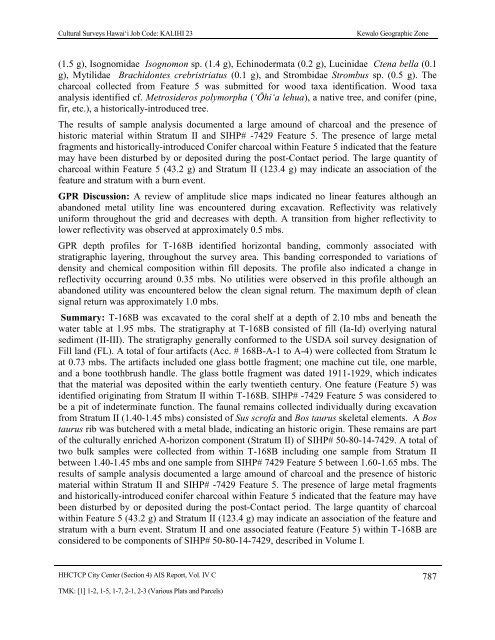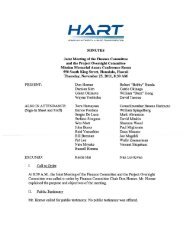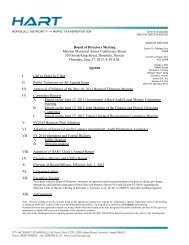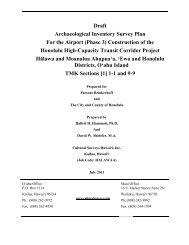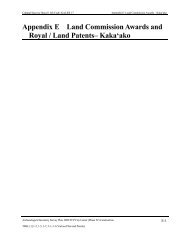4.12 Test Excavation 167 (T-167) - Honolulu Rail Transit Project
4.12 Test Excavation 167 (T-167) - Honolulu Rail Transit Project
4.12 Test Excavation 167 (T-167) - Honolulu Rail Transit Project
Create successful ePaper yourself
Turn your PDF publications into a flip-book with our unique Google optimized e-Paper software.
Cultural Surveys Hawai‘i Job Code: KALIHI 23Kewalo Geographic Zone(1.5 g), Isognomidae Isognomon sp. (1.4 g), Echinodermata (0.2 g), Lucinidae Ctena bella (0.1g), Mytilidae Brachidontes crebristriatus (0.1 g), and Strombidae Strombus sp. (0.5 g). Thecharcoal collected from Feature 5 was submitted for wood taxa identification. Wood taxaanalysis identified cf. Metrosideros polymorpha (‘Ōhi‘a lehua), a native tree, and conifer (pine,fir, etc.), a historically-introduced tree.The results of sample analysis documented a large amound of charcoal and the presence ofhistoric material within Stratum II and SIHP# -7429 Feature 5. The presence of large metalfragments and historically-introduced Conifer charcoal within Feature 5 indicated that the featuremay have been disturbed by or deposited during the post-Contact period. The large quantity ofcharcoal within Feature 5 (43.2 g) and Stratum II (123.4 g) may indicate an association of thefeature and stratum with a burn event.GPR Discussion: A review of amplitude slice maps indicated no linear features although anabandoned metal utility line was encountered during excavation. Reflectivity was relativelyuniform throughout the grid and decreases with depth. A transition from higher reflectivity tolower reflectivity was observed at approximately 0.5 mbs.GPR depth profiles for T-168B identified horizontal banding, commonly associated withstratigraphic layering, throughout the survey area. This banding corresponded to variations ofdensity and chemical composition within fill deposits. The profile also indicated a change inreflectivity occurring around 0.35 mbs. No utilities were observed in this profile although anabandoned utility was encountered below the clean signal return. The maximum depth of cleansignal return was approximately 1.0 mbs.Summary: T-168B was excavated to the coral shelf at a depth of 2.10 mbs and beneath thewater table at 1.95 mbs. The stratigraphy at T-168B consisted of fill (Ia-Id) overlying naturalsediment (II-III). The stratigraphy generally conformed to the USDA soil survey designation ofFill land (FL). A total of four artifacts (Acc. # 168B-A-1 to A-4) were collected from Stratum Icat 0.73 mbs. The artifacts included one glass bottle fragment; one machine cut tile, one marble,and a bone toothbrush handle. The glass bottle fragment was dated 1911-1929, which indicatesthat the material was deposited within the early twentieth century. One feature (Feature 5) wasidentified originating from Stratum II within T-168B. SIHP# -7429 Feature 5 was considered tobe a pit of indeterminate function. The faunal remains collected individually during excavationfrom Stratum II (1.40-1.45 mbs) consisted of Sus scrofa and Bos taurus skeletal elements. A Bostaurus rib was butchered with a metal blade, indicating an historic origin. These remains are partof the culturally enriched A-horizon component (Stratum II) of SIHP# 50-80-14-7429. A total oftwo bulk samples were collected from within T-168B including one sample from Stratum IIbetween 1.40-1.45 mbs and one sample from SIHP# 7429 Feature 5 between 1.60-1.65 mbs. Theresults of sample analysis documented a large amound of charcoal and the presence of historicmaterial within Stratum II and SIHP# -7429 Feature 5. The presence of large metal fragmentsand historically-introduced conifer charcoal within Feature 5 indicated that the feature may havebeen disturbed by or deposited during the post-Contact period. The large quantity of charcoalwithin Feature 5 (43.2 g) and Stratum II (123.4 g) may indicate an association of the feature andstratum with a burn event. Stratum II and one associated feature (Feature 5) within T-168B areconsidered to be components of SIHP# 50-80-14-7429, described in Volume I.HHCTCP City Center (Section 4) AIS Report, Vol. IV C 787TMK: [1] 1-2, 1-5, 1-7, 2-1, 2-3 (Various Plats and Parcels)


